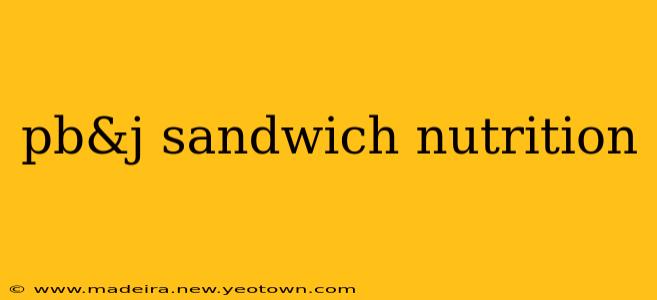The peanut butter and jelly sandwich. A childhood staple, a lunchtime classic, a quick and easy snack. But beyond its simple construction lies a surprisingly nuanced nutritional profile. This isn't just kid food; it's a surprisingly well-rounded meal that can contribute to a balanced diet when crafted thoughtfully. Let's unpack the nutritional powerhouse that is the PB&J.
What are the nutritional benefits of a PB&J sandwich?
The beauty of the PB&J lies in its synergistic combination of ingredients. Peanut butter delivers healthy fats, protein, and essential vitamins and minerals. Jelly, while often viewed as the "lesser" half, provides a dose of natural sugars and antioxidants, depending on the type. Together, they offer a decent source of energy, protein for satiety, and various micronutrients to support bodily functions.
How many calories are in a PB&J sandwich?
Calorie count varies dramatically depending on the size of the sandwich, the type of bread used, and the amount of peanut butter and jelly. A typical sandwich, made with two slices of white bread, two tablespoons of peanut butter, and one tablespoon of jelly, might clock in around 300-400 calories. Opting for whole-wheat bread and reducing the amount of peanut butter can significantly lower the calorie count.
What are the different types of peanut butter and which is healthiest?
This is where things get interesting. Not all peanut butters are created equal. Many commercially available peanut butters contain added sugar, salt, and partially hydrogenated oils (trans fats). Natural peanut butter, with only peanuts (and maybe a little salt) as ingredients, is the healthiest choice. Look for brands that clearly state "no added sugar" or "just peanuts." Be aware that natural peanut butter often requires stirring due to the separation of oil and solids.
What are the health benefits of peanut butter?
Peanut butter is a nutritional goldmine. It's an excellent source of:
- Protein: Essential for building and repairing tissues.
- Healthy Fats: Monounsaturated and polyunsaturated fats contribute to heart health.
- Fiber: Promotes digestive health and keeps you feeling full.
- Vitamin E: A powerful antioxidant.
- Magnesium: Important for muscle function and energy production.
- Potassium: Crucial for maintaining healthy blood pressure.
What are the health benefits of jelly?
The health benefits of jelly are less pronounced than those of peanut butter, but it's not entirely devoid of nutritional value. Opting for fruit-based jellies with minimal added sugar offers some advantages:
- Antioxidants: Depending on the fruit, jellies may provide small amounts of antioxidants, though often less than the fruit itself.
- Vitamins: Trace amounts of vitamins may be present, depending on the fruit used.
However, it's crucial to carefully check the ingredient list. Many jellies are high in added sugars, which can negatively impact health if consumed in excess.
Is a PB&J sandwich good for weight loss?
A PB&J sandwich can be part of a weight-loss diet, but moderation is key. The calorie and fat content can contribute to weight gain if consumed in excess. Choosing whole-wheat bread, reducing the amount of peanut butter, opting for natural peanut butter with no added sugar, and selecting low-sugar jellies are crucial for making a PB&J a weight-loss-friendly choice.
Is a PB&J sandwich good for muscle growth?
While not a primary muscle-building food, a PB&J contributes to muscle growth through its protein content. Peanut butter provides a good source of protein, essential for muscle repair and growth. However, to maximize muscle growth, incorporate other high-protein foods into your diet.
The humble PB&J is more than just a convenient snack; it's a flexible, adaptable meal option with a surprising amount of nutritional value. By making informed choices about ingredients and portion sizes, you can transform this childhood classic into a healthy and satisfying part of your daily diet.

